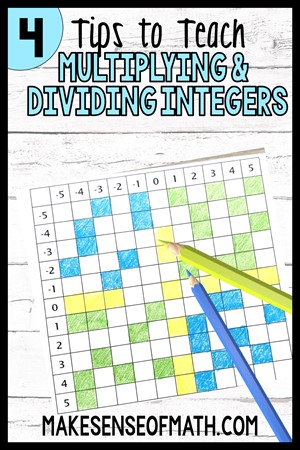I've got some great tips for teaching the rules for multiplying and dividing integers. These three tips focus on discovery, making sense of the math, and extending reasoning. Teaching this way will help your middle school math students retain the rules of multiplication of integers. Also, if you don't want to make your own products to help your students, I've got some for you below that will make your life easier.
Tip 1: Discovery
Give them a multiplication chart similar to the blank one below and a calculator.
Have them use their calculator to complete the multiplication problems. Color the positive products one color and the negative products a different color. After students have completed their multiplication chart have a conversation with open-ended questions such as: What patterns do you notice?
Have them use their calculator to complete the multiplication problems. Color the positive products one color and the negative products a different color. After students have completed their multiplication chart have a conversation with open-ended questions such as: What patterns do you notice?
Tip 2: Number lines
Before using number lines to teach the rules of multiplication of integers, I always talk about thinking of multiplication as "groups of" then translate the problem into words.
Here is an example:
- 5(2): 5 groups of 2
- 5(-2): 5 groups of -2
Now, you can't actually have a negative group of something. In the case of a negative first, students can think of this as the opposite, and bounce to the opposite number on the number line.
- -5(2): The opposite of 5 groups of 2
- -5(-2): The opposite of 5 groups of -2
Tip 3: Extend their thinking
After they have a good grasp of opposites, and how opposites cancel each other out. Extend their thinking by determining the product or quotient of more than two integers. The best way to do this is with 1's, so they are not wasting their time on actually multiplying, rather just the signs. You could give them a list of problems like the one below, and have them notice the pattern. Even number of integers = positive, and odd number of integers = negative. Have them explain why this is true. You could even throw some ones in there, to show that will not effect the sign of the product.
- (1)(-1)
- (-1)(-1)
- (-1)(-1)(-1)
- (-1)(-1)(-1)(-1)
- (-1)(-1)(-1)(-1)(-1)
Tip 4: Apply to division
All of the above tips focus on the product of integers. Make sure to extend this to division. Again, use open-ended questions to help your students make connections.
- How are multiplication and division related?
- How can you convert a multiplication problem into a division problem? (i.e. divide by 2 = multiply by 1/2
OK...So there are my tried and true tips for teaching the rules for multiplying and dividing integers.
If you don't want to make your own resources for teaching integers, I've got you covered.
The integer operation notes cover all the four operations of integers. They teach using number lines, which are all pre-made in the notes. They also include additional practice for the students. Include great in-depth questioning to get your students critically thinking. Click on the image below for more information. OR CLICK HERE TO CHECK THESE OUT ON MY MAKE SENSE OF MATH STORE.
The multiplying and dividing integers stations are one of my best-selling resources. They have students use both the discovery method, and number lines, and extend the knowledge to division. Click on the image below for more information. OR CLICK HERE TO CHECK THESE OUT ON MY MAKE SENSE OF MATH STORE















